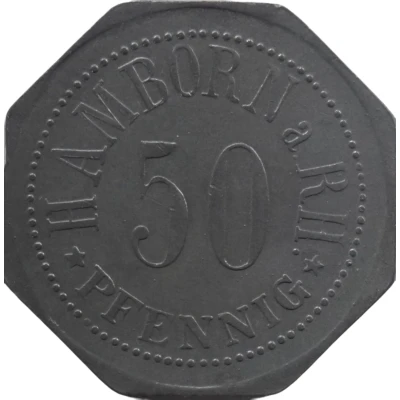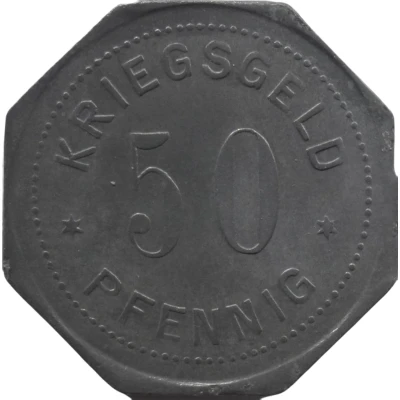


© Willem63 (CC BY-NC-SA)
50 Pfennigs - Hamborn ND
1917 year| Zinc | 3.6 g | 24.7 mm |
| Issuer | City of Hamborn (Prussian province of Rhine) |
|---|---|
| Emperor | William II (Wilhelm II) (1888-1918) |
| Type | Standard circulation coin |
| Year | 1917 |
| Value | 50 Pfennigs (50 Pfennige) (0.50) |
| Currency | Mark (1914-1924) |
| Composition | Zinc |
| Weight | 3.6 g |
| Diameter | 24.7 mm |
| Thickness | 1.2 mm |
| Shape | Octagonal (8-sided) |
| Technique | Milled |
| Orientation | Medal alignment ↑↑ |
| Demonetized | Yes |
| Updated | 2024-10-04 |
| Numista | N#64604 |
|---|---|
| Rarity index | 80% |
Reverse
Pearl rim, legend surrounding denomination.
Script: Latin
Lettering:
KRIEGSGELD
50
✶ PFENNIG ✶
Edge
Plain
Comment
Other sources indicate as Mint: Carl Marks, HambornInteresting fact
The 50 Pfennigs - Hamborn ND (1917) coin was minted during a time of economic turmoil in Germany, known as the "Inflationary Period" (1914-1923). During this time, the value of the German mark (the national currency) plummeted, and prices for everyday goods skyrocketed. As a result, many Germans turned to alternative forms of currency, such as local emergency currencies like the 50 Pfennigs - Hamborn ND (1917) coin. This coin, made of zinc and weighing 3.6 grams, was issued by the City of Hamborn in the Prussian province of Rhine and was used as a substitute for the rapidly devaluing German mark. Despite its humble origins, the 50 Pfennigs - Hamborn ND (1917) coin remains a fascinating piece of numismatic history, offering a glimpse into a unique period of economic upheaval and innovation.
Price
| Date | Mintage | VG | F | VF | XF | AU | UNC |
|---|---|---|---|---|---|---|---|
| ND (1917) | 20000 | - | - | - | - | - | - |
Values in the table are based on evaluations by sales realized on Internet platforms. They serve as an indication only for 50 Pfennigs - Hamborn ND (1917) coin.